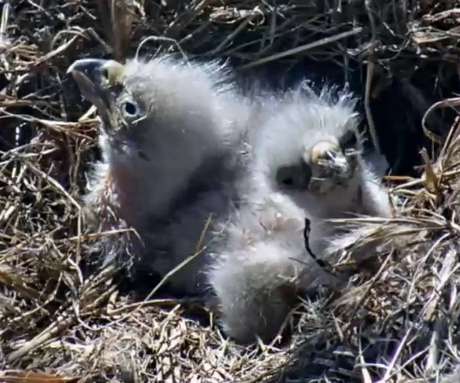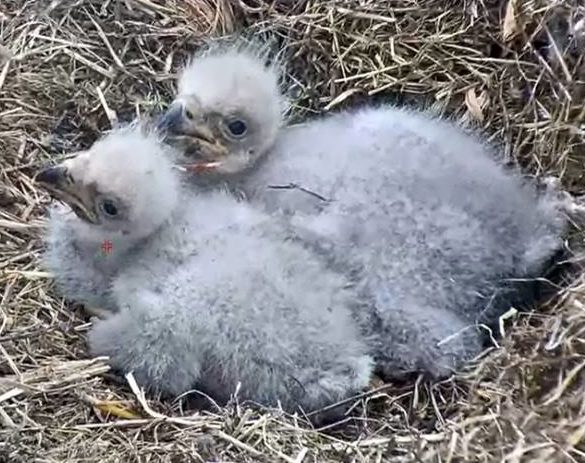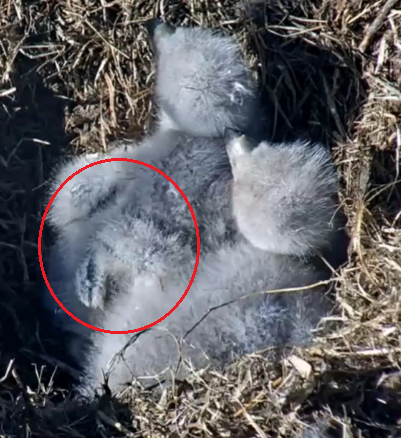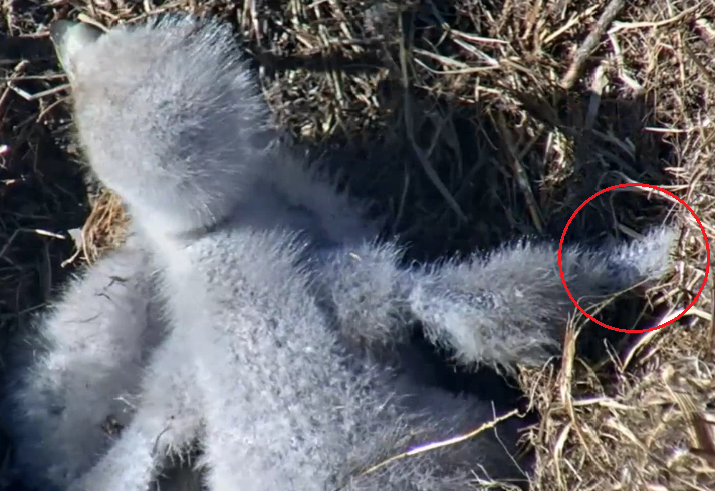At the Bluff City nest in Tennessee this week (March 17-23, 2019) we are witnessing the three phases of feather development on a growing eaglet. This nest is live-streamed online by East Tennessee State University, and photos are used with permission. Link to the cam.

On Sunday the two eaglets (BC14 and BC15) were covered with their light gray natal down. These fluffy feathers, called “plumulaceous,” grow in tracts, or rows, that are layered more or less evenly across the skin. The feathers are thin and are not good insulators.
On Wednesday for BC14, and then on Thursday for BC15, we began to see the secondary down feathers emerge. This dark gray layer of down can appear as early as Day 6 after hatch. It is thicker and provides better insulation than the natal down, hence is sometimes called thermal down, as it helps the eaglets begin to self-thermoregulate. The secondary down soon will cover the natal down (but does not replace it because it grows from a different set of follicles). In this photo you can see the dark gray feathers appearing between the neat light-colored rows of natal down feathers.

Within a few days, even while the thermal down is still growing, the follicles that produced the natal down will begin to produce “pennaceous” feathers, ones with a central shaft that makes them stiff, and barbs and barbules that lock together. The shaft has blood vessels running through it as it grows, hence the name blood feather, sometimes also called a pen- or pin-feather (adapted from “pennaceous”). These contour feathers, which include the wing and tail flight feathers, will grow over several weeks to create a protective covering of the eagle’s entire body.

Pin-feathers begin to emerge around Day 12 after hatch, and today at Bluff City, right on time, BC14’s and B15’s wings show a thin line of dark brown feathers at the back edge of the wing. The flight feathers on the wings, the remiges, are the first to begin to grow because they are the longest and take the most time to reach their full length.

In this photo you can see the light gray tips of the natal down feathers that are being pushed out by the growing remiges.
So for the next few days we will be able to see all three types of feathers on the Bluff City eaglets: natal down, thermal down, and contour feathers. The contour feathers will eventually replace the natal down completely, leaving only the thermal down underneath. Contour feathers will appear slowly on the back, then the tail, shoulders, neck, head, sides, chest and belly, and finally the legs and feet. The feathers on the backs of the feet will be the last to grow in because the eaglets will only gradually develop the strength and balance to walk on their toes like their parents do, and feathers would not withstand the wear and tear of constant contact with nest materials.

You must be logged in to post a comment.